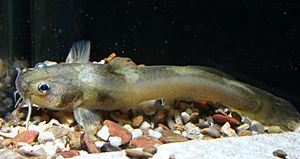Chucky madtom facts for kids
Quick facts for kids Chucky madtom |
|
|---|---|
 |
|
| Conservation status | |
| Scientific classification |
The chucky madtom (Noturus crypticus) is a very rare freshwater fish. It lives only in the U.S. state of Tennessee. This makes it endemic to Tennessee, meaning it's found nowhere else in the world.
Scientists have seen it in two streams in eastern Tennessee: Little Chucky Creek and Dunn Creek. But it hasn't been seen in Dunn Creek since 1940. So, it probably doesn't live there anymore. Because this fish is so rare, we don't know much about its life. For example, we don't know what it eats or how it lays its eggs. However, scientists think it might lay eggs in early summer.
The number of chucky madtoms is very low. This is likely because its home is getting damaged. People are working to protect the streams where it lives. In 2004, a special program started to breed these fish in captivity. The chucky madtom only lives in a small part of Little Chucky Creek, about 3 kilometers (1.9 miles) long. It was first described as a new species in 2005.
Contents
What Does the Chucky Madtom Look Like?
The chucky madtom is a small fish. It grows to be about 6.5 centimeters (2.6 inches) long. That's about the length of a credit card! It has a pale color with some dark spots or blotches on its body.
Where Does the Chucky Madtom Live?
The chucky madtom lives in a very small area. It is only found in two streams in eastern Tennessee. These streams are part of the French Broad River system. Only one chucky madtom was ever found in Dunn Creek. That was back in 1940. Scientists believe the fish no longer lives in Dunn Creek.
Most of the chucky madtoms found have been in Little Chucky Creek. This creek is in Greene County, Tennessee. It's a mystery why these two small streams are the only places where this fish lives. There are other places nearby that seem like good homes for them. But surveys of these areas have not found any more chucky madtoms. The streams where they live have mussels, which means the water is clean and healthy.
The parts of Little Chucky Creek where the chucky madtom lives have slow-moving water and some areas with moderate flow. The bottom of these streams is usually made of gravel or flat rocks.
What Do We Know About Its Life?
Because there are so few chucky madtoms, scientists don't know much about their daily lives. We don't know what they eat or what animals might hunt them. We also don't know when they lay eggs, how many eggs they lay, or how many males and females there are. It's hard for researchers to study them because they are so rare and protected.
However, we can learn from other types of madtoms. For example, the least madtom is ready to have babies when it is one year old. Other madtoms, like the least madtom, lay their eggs from late spring to early summer. Smoky madtoms often build their nests under flat rocks. They also eat a lot of mayfly nymphs. The chucky madtom might have some of these same habits.
How Are We Helping the Chucky Madtom?
The chucky madtom is a federally endangered species. This means it is protected by the government. A group called Conservation Fisheries Inc. (CFI) is working to help it. CFI is a non-profit group in Knoxville, Tennessee. They work to bring back natural species. They have special programs to breed endangered fish in captivity. This helps keep the variety of fish in southeastern streams alive.
CFI started a breeding program for the chucky madtom. They collected a male and female fish to live at their facility. Sadly, the female fish died before they could have babies.
CFI believes that farming near the streams has hurt the chucky madtom's home. If farms don't use good practices, soil can wash into the streams. This is called siltation. Siltation covers up places where the fish can hide and find food. It can also make it hard for the chucky madtom to eat and lay eggs.
The Middle Nolichucky Watershed Alliance (MNWA) is helping to restore the chucky madtom's home. They have two main goals:
- Protect the habitat: They want to make sure the land around the streams is used properly. This will help keep the water clean. It will also fix problems like bad septic tanks and other pollution.
- Learn more about the fish: They need to gather more information about the chucky madtom's life. This will help them manage its food sources and other important factors.
See also
 In Spanish: Noturus crypticus para niños
In Spanish: Noturus crypticus para niños


